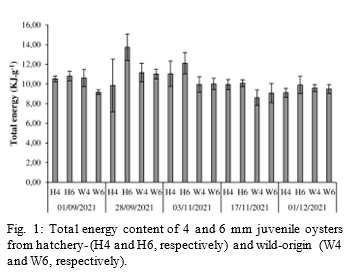OVERWINTERING SURVIVAL IN JUVENILE OYSTERS: UNDERSTANDING THE ROLE OF ENERGETIC PHYSIOLOGY FOR Crassostrea virginica SEED
The American oyster Crassostrea virginica is an important cultivated oyster species, providing every year several millions of dollars to fishery and aquaculture economies. This species expands over 4 000 kms on the East American coast, from the Gulf of Mexico to the Gulf of St-Lawrence where oysters experience harsh winter conditions such as sub-zero temperatures during 3-4 months. In response to this temperature constraint, adult oysters decrease the unsaturation index of their polar lipids during the fall acclimation period to adjust the fluidity of their cell membranes and progressively reduce their metabolism to a near standstill during winter. Throughout this dormancy phase, Crassostrea virginica stops feeding and mobilize its energetic reserves (lipids and to a lesser extent proteins) to maintain vital physiological functions. However, the metabolic strategies of oyster spats during winter are still understudied, although they represent a crucial stage determining the production of adult oysters and economic performances of hatcheries.
This study aims to investigate the link between survival rates of hatchery and wild juvenile oysters in relation to their size and energetic reserves. An 8-months experiment is being conducted from September 2021 to May 2022 to monitor energetic reserves and lipid dynamics of Crassostrea virginica spats from the fall acclimatation to the end of winter dormancy. Juveniles from two origins (i.e. hatchery vs wild) and two sizes (i.e. 4 vs 6 mm) are reared both in hatchery under ambient condition (experimental group) and in the wild (control group). Total energy content is estimated through total lipids, proteins and carbohydrates analyses. In addition, lipid classes and fatty acid composition of neutral and polar lipids are analyzed to examine the dynamic of storage lipids and track seasonal metabolic adjustments in oyster spats.
According to first preliminary results, oyster spats have already low energetic reserves during the fall acclimatation period (Fig. 1). However, no differences are observed between hatchery and wild juveniles, suggesting that hatchery seeds used in aquaculture have a similar physiological performance than those collected in the wild. All the results obtained at the end of the experiment will allow to better understand the energetic physiology of oyster spats during winter. This study will also provide new insights to oyster producers to predict the overwintering success of juvenile oysters and maximize winter survival by improving their diet in hatchery before release into the wild.
